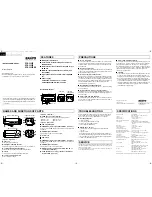
253
Technical Notes
4 The shift knob for the PC-E NIKKOR 24mm f/3.5D ED may contact the camera body when the
lens is revolved.
5 Shifting and/or tilting the lens interferes with exposure.
6 Can not be used with shifting or tilting.
7 Optimal exposure will only be achieved if the lens is at maximum aperture and the lens is not
shifted or tilted.
8 When AF 80–200mm f/2.8, AF 35–70mm f/2.8, AF 28–85mm f/3.5–4.5 (New), or
AF 28–85mm f/3.5–4.5 lenses are zoomed all the way in at the minimum focus distance, the
in-focus indicator (
I
) may be displayed when the image on the matte screen in the viewfinder
is not in focus. Before shooting, confirm that the image in the viewfinder screen is in focus.
9 With maximum aperture of f/5.6 or faster.
•
Noise in the form of lines may appear during autofocus when movies
are recorded at high ISO sensitivities. Use manual focus or focus lock.
D
IX NIKKOR Lenses
IX NIKKOR lenses can not be used. Attempting to attach an IX NIKKOR
lens could damage the lens or camera.
A
Identifying CPU and Type G, E, and D Lenses
CPU lenses can be identified by the presence of CPU contacts, type G,
E, and D lenses by a letter on the lens barrel. Type G and E lenses are
not equipped with a lens aperture ring.
CPU contacts
Aperture ring
CPU lens
Type G or E lens
Type D lens
A
Type D Lenses
Type D lenses may only be used when the camera is in mode
M
.
Selecting another mode disables the shutter release. Aperture must
be adjusted manually via the lens aperture ring and the camera
metering system and i-TTL flash control can not be used.
















































